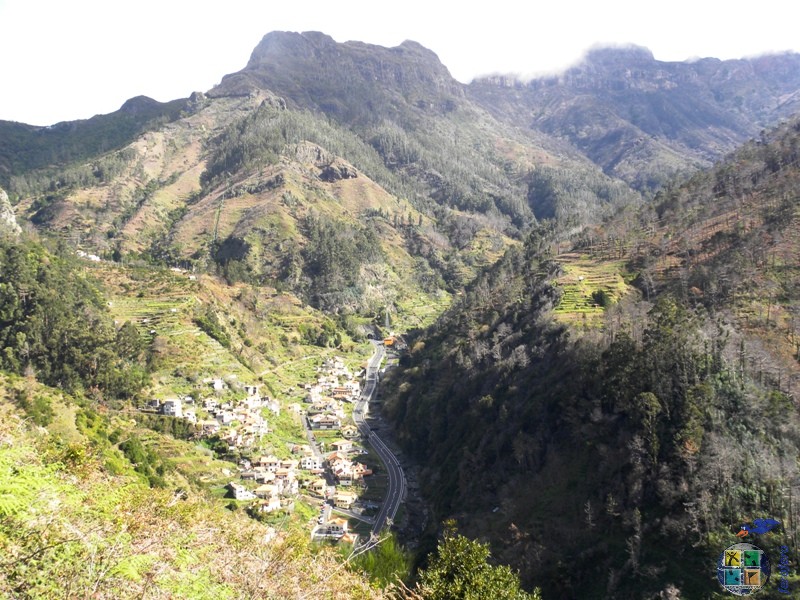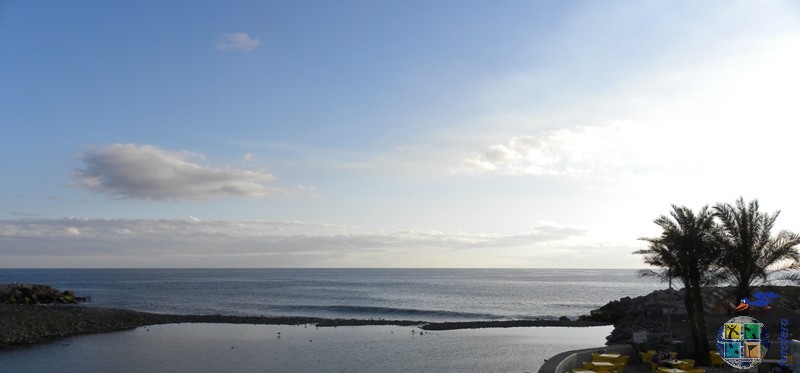Translation: 




A Ribeira Brava é uma vila situada na parte sudoeste da ilha da Madeira. A sua origem é dos primórdios da colonização da ilha, ainda no século XV. É uma das freguesias mais antigas, tendo ganho esse estatuto depois de 1460, logo a seguir ao Funchal e a Machico. A origem da sua designação deve-se à ribeira, que em períodos de chuva, rapidamente se transforma num curso de água com caudal muito forte, que tem provocado algumas catástrofes históricas, como foi em 1803 e 2010.
Ribeira Brava is a village located in the southwestern part of Madeira island. Its origin is from the early days of colonization of the island, even in the fifteenth century. It is one of the oldest parishes, having gained that status after 1460, just after the Funchal and Machico.The origin of its name due to the riverside, which in periods of rain, quickly turns into a water course with very strong flow, which has caused some historical catastrophes, as in 1803 and 2010.

Esta localidade ganhou importância devido à ribeira e ao seu vale, que facilitaram a ligação com o Norte da ilha e também, a comunicação com toda parte Oeste da Madeira. Entre 1904 e 1908 foi construído um pequeno cais de acostagem e desembarque na parte Este da vila, para o qual foi construído um túnel de acesso, contribuindo ainda mais para o incremento das ligações com o exterior.
This locality has gained importance due to the riverside and its valley, which facilitated the connection with the north of the island, and also, the communication with all the western part of the Madeira. Between 1904 and 1908 was built a small pier on the east of the village, which was built for an access tunnel, further contributing to the increase in connections with the exterior.

A partir desta pequena vila foi criado um concelho a 6 de maio de 1914, com quatro freguesias, Tábua, Serra de Água, Campanário e Ribeira Brava, que abrangem uma área de 65km2. Destacam-se algumas edificações que resistiram ao tempo e contam um pouco da sua história.
From this small village was created a municipality on May 6, 1914, with four parishes, Tábua, Serra de água, Campanário and Ribeira Brava, covering an area of 65km2. Some buildings that survived the time and tell a little of its history.

|
|
Forte de São Bento
Pequena fortificação mandada construir em 1708, para defender as populações dos piratas e corsários. Mais tarde, em 1920 serviu de prisão ao serviço da Câmara Municipal. Atualmente é um posto de informação turística.
A small fort ordered to be built in 1708 to defend the people from pirates and corsairs. Later, in 1920 served as a prison in the service of Town Hall. Currently, it is a tourist information office.
|

Solar dos Herédias - Câmara Municipal de Ribeira Brava
Antiga moradia do fundador do concelho e visconde da Ribeira Brava, Francisco Correia Herédia. É um edifício datado do final do séc. XVIII e foi classificado como Monumento Municipal desde 1994. Hoje é sede da Câmara Municipal da Ribeira Brava. Em redor do edifício existe um verdejante jardim, visitável de segunda a sexta, das 9h às 17h30.
was the former home of the founder of the municipality and viscount of Ribeira Brava, Francisco CorreIa de Herédia. It is a building dating from the end of the century. XVIII and was classified as Monument Municipal since 1994. Today is home of the Municipality of Ribeira Brava. Around the building there is a green garden, open to visitors Monday to Friday, 9am to 17:30.

Museu Etnográfico - Engenho
No inicio do Séc XVII era um convento Franciscano sob domínio do convento de Santa Clara, quando, em 1682 foi comprado pelo Capitão Gonçalves Silva, que acrescentou um andar e estabeleceu ali a sua moradia. Mais tarde, em 1710 mandou erger uma capela dedicada ao patriarca São José. Em 1853 esta edificação assumiu novo desempenho, tendo sido ali estabelecida uma unidade industrial, com um engenho de moer cana-de-açucar de tracção animal e um alambique de destilação de aguardente. Em 1862, o engenho passou a utilizar energia hidráulica, com a instalação de uma roda motriz de madeira servida por uma levada. Mais tarde, também foram instalados dois moinhos de cereais. Atualmente, no lado norte do edifício, é possível ver uma torre, que antes suportava o aqueduto que trazia a água para mover uma mais recente roda motriz em metal, ainda visível no local.
At the beginning of the XVII Century was a Franciscan convent in domain of the convent of Santa Clara, when, in 1682 was bought by Captain Silva Gonçalves, who added a floor and there established his home. Later in 1710 he built a chapel dedicated to the patriarch St. Joseph In 1853 this building became the new performance, having been established there an industrial unit with a mill for grinding sugar sugar cane, of animal traction and an alembic distilling brandy. In 1862, the mill began to use water power, with the installation of a driving wheel of wood, served by a water channel. Later, also have been installed, two grain mills. Currently, in the north side of the building, you can see a tower, which once supported the aqueduct that brought water to move a driving wheel, in metal, still visible on site.

Igreja de São Bento
O atual templo é o resultado de diversos acrescentos e modificações desde a sua primeira edificação que remonta à segunda metade do século XVI. Conserva um valioso património de arte sacra, entre retábulos, pinturas e variadas peças em prata.
The current temple is the result of several additions and modifications since its first building that dates from the latter half of the sixteenth century. Retains a rich heritage of sacred art, from altarpieces, paintings and various pieces of silver
Depósitos aluvionares
Onde a Vila da Ribeira Brava se desenvolve, outrora deambulou o caudal desta vigorosa ribeira, que transportou enormes quantidades de materiais de diversas dimensões, entre argilas, areias, seixos e grandes blocos. Estes materiais foram depositados ao logo das margens e nas zonas de estuário, em especial em momentos de aluvião (fenómeno meteorológico associado a elevada precipitação e transporte de materiais rochosos), dando origem a depósitos.
O local indicado pelas coordenadas apresenta um exemplo de um depósito aluvionar muito compactado e cimentado, situado no extremo oposto ao atual leito da ribeira, evidenciando que toda a área urbana já foi local de passagem da Ribeira Brava.
Alluvial deposits
Where the village of Ribeira Brava develops, strolled past the vigorous flow of this riverside, which carried huge amounts of materials of various sizes, including clay, sand, pebbles and large blocks. These materials were deposited just at the margin areas and estuaries, in particular during times of alluvium (associated to weather conditions with high precipitation and transport rock materials), giving rise to deposits.
The location indicated by the coordinates gives an example of an alluvial deposit very compacted and cemented, located at the opposite end to the current stream bed, proving that the entire urban area was once a place of passage of Ribeira Brava.



A Cache: Esta é uma cache épica, depois de várias localizações e containers, finalmente encontrou um local estável por uns tempos...
O objetivo é dar a conhecer alguns pontos de interesse na vila de Ribeira Brava, acompanhando a informação disponível.
A descoberta do container pode ser feita numa única etapa! Depois de um pequeno passeio, procure com todo o cuidado no local indicado pelas coordenadas, antes consulte as dicas.
Não force nada, segure a cache muito bem para que não caia. Reponha tudo exatamente como encontrou.
The Cache: This is an epic cache, after several locations and containers, finally found a stable place for a while...
The objective is to present some interest points in the Ribeira Brava village, following the information available.
The discovery of the container can be made in a single step. After a short walk, look carefully at the location indicated by the coordinates, see the hints before.
Do not force anything, hold the cache well lest he fall. Replace everything exactly as found.
Leve papel e caneta e parta à descoberta desta multi-cache:
Take pen and paper and begins to explore this multi-cache:
Stage 1 - Igreja de São Bento: N 32° 40.271 W 017° 03.881
PT: Quantos azulejos constituem a imagem de Nossa Senhora de Fátima? = A
EN: How many tiles are the image of "Nossa Senhora de Fátima"? = A
Vila Brava - Final Location
N 32º 40. (80-A) (81-A) (80-A)
W 017º 03. (86-A) (80-A) (81-A)
Por favor não coloque imagens da cache, nem do local onde está escondida.
Please do not post images of the cache or the place where it is hidden
 FTF ....
FTF ....
 STF ....
STF ....
 TTF ....
TTF ....
